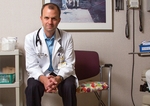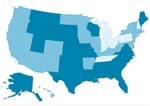business
New technology coming to boost preventive care
■ A practical look at information technology issues and usage
- WITH THIS STORY:
- » External links
As more emphasis is put on health technology and preventive care, new solutions promise to engage patients in taking control of wellness and disease prevention by using interactive, patient-oriented technology that works with data from physicians’ electronic health record systems.
Patients have proven that they will use technology that is easy to access, such as mobile phone apps or remote monitoring devices. But these stand-alone systems have offered little in the way of personalized medicine. At the same time, physicians are adopting technology that offers alerts, advice and decision support based on best practices. But those systems don’t engage the patient or take into account information that might make the clinical guidance specific to each person. Technology vendors are discovering that combining consumer and physician tools can be powerful.
Tools that combine a physician’s EHR, a patient’s personal health record, and best practices to produce information that is distributed in a convenient, easy-to-access way is where the industry is headed, said Alex Krist, MD, MPH, a family physician and associate professor with the Dept. of Family Medicine at Virginia Commonwealth University School of Medicine.
The tools come in many forms. Some will be sold to patients in the consumer market. Some will be add-ons to the EHRs and patient portals many practices already are implementing. And others will be benefits that insurance plans offer members. But all will help doctors improve outcomes and earn more in new models of physician compensation.
Some examples of technology and preventive care colliding:
Interactive preventive health record. Dr. Krist said PHRs, as they exist today, are not as personalized or as interactive as they should be. An interactive preventive health record brings the PHR and the physician’s EHR together to create personalized alerts, aimed at preventive services, that are sent to both patients and physicians based on a patient’s medical history, age and other identifying characteristics. A prototype IPHR was developed by Dr. Krist and eight other researchers who conducted a pilot study of its effectiveness in eight primary care offices. One of the challenges with any kind of system that places the patient in the driver’s seat is making sure the patient acts on the information, said Jim D’Itri, principal of CSC’s Healthcare Group.
To that end, Dr. Krist and his colleagues designed the system to send alerts to both patients and physicians. In some cases, Dr. Krist said, a patient would see an alert and call the practice to follow up. In other cases, the practice would contact the patient to initiate the action. Dr. Krist said practices also differ in how they deal with the alerts. Some are better equipped to take action and initiate communication with patients. Sending alerts to both patients and physicians helps improve the likelihood of action.
The pilot study found that 25.1% of patients who had access to an IPHR were up to date on all preventive services, double the rate of nonusers. The results of the study were published in the July/August issue of the Annals of Family Medicine.
The intellectual property rights to the system evaluated for the study, called MyPreventiveCare, are owned by Virginia Commonwealth University. It is not available commercially but is in place at 14 practices, with a total of 30,000 patients using the technology, Dr. Krist said.
Dr. Krist worked on a separate project with the Agency for Healthcare Research and Quality to produce a handbook for practices that already have an EHR on how to implement their own versions of an IPHR.
Mobile technology. There is a huge opportunity around personal devices being used to send reminders and alerts to patients about preventive care measures, said Laura Kreofsky, principal of Impact Advisors, a health care technology consulting firm. And the mobile device market is evolving so rapidly, she said, “There’s no doubt there will be better integration with PHRs and mobile devices” in the very near future.
Kreofsky said many mobile apps now send push notifications to users for a variety of health-related reasons. When those apps can draw personalized data from outside sources, such as an EHR, and tailor the alerts to the specific patient, it will have a tremendous effect on preventive care. Pilot programs have tested this type of technology with people who have chronic disease and need continuous monitoring and tests have proven successful.
D’Itri said physicians generally support this technology as long as alerts are innocuous, such as a suggestion to see a doctor, he said, and not a specific treatment suggestion that could lead to a bad outcome.
Some of this integration is coming from insurers, who have a plethora of useful patient data that can be integrated with mobile apps. One example is UnitedHealth Group subsidiary OptumRx’s “My Medications Reminder” app. It can remind patients to fill, take or refill specific prescriptions.
Patient-specific decision support and communication. Stage 1 of meaningful use helped set the stage for improved patient engagement. Criteria included optional objectives for physicians to generate lists of patients with certain conditions and to communicate with patients about preventive and follow-up care based on their conditions.
Stage 2 will build on stage 1. And although requirements for stage 2 are not finalized, they are sure to include the optional objectives from stage 1 as a requirement. This means there will be a strong focus on patient-centered care and communication. Not only will physicians have access to patient-specific decision support, but they also will have the incentive to communicate those recommendations to the patient. This will encourage more practices to push PHR use among their patients and to use secure communication functions within the PHR.
Kreofsky said physicians likely will soon have the ability to generate messages encouraging patient action based on what is found in their EHRs. “A personal message from your clinician will probably prompt a more immediate response than anything,” she said.
Kreofsky said she can imagine a day when data from PHRs and EHRs come together to generate personalized information that then will be sent to the physician’s decision support system and to the patient’s IPHR. And the IPHR will have a mobile component to display real-time alerts and reminders to patients over their smartphones.
Dr. Krist said that as more data are integrated, and patients learn how to access and use this information, “vendors, practices and patients will all push the development of these systems.”
But there are some issues to work out, according to D’Itri. The technology is already there to provide personalized alerts and guidance. “But the problem we often don’t talk about it is that you presume your information is located all in one place. The reality is that it typically is not,” D’Itri said.
That is part of what the Health Information Technology for Economic and Clinical Health Act, which created meaningful use incentives, intended to do — bring all of that information together. “So the promise is there,” he said. “The idealistic view is that all of this will be worked out, which I believe it will.”












